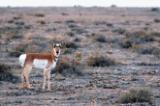 © Mike Norton (Colorado)
© Mike Norton (Colorado)

Featured Animals in Colorado
The iconic, the rare, and the just plain interesting. Read on for an overview of some of Colorado's most notable animals. Click on the links below to access brief profiles of some of our priority species at risk.
Iconic Animals
Colorado supports numerous charismatic species commonly associated with our State. Pronghorn, the fastest land animals in North America, roam the prairies and sagebrush shrublands. Evolving in flat to rolling hills dominated by short-statured plants, these animals do not jump and will scoot under barb wire fences rather than jumping over them like other large game species. Elk and mule deer dominate Colorado’s mountain systems, easily clearing 6-foot tall fences while out-maneuvering predators. Mountain lions commonly prey on mule deer and young elk, while the rare, elusive, and re-introduced lynx survive where snowshoe hares are numerous. Black bears are also relatively common in Colorado’s forests. Although usually elusive, they will invade garbage cans and houses in search of food, especially during drought conditions. And the nimblest of all of Colorado’s large animals is the rock-loving big-horn sheep which will inspire even the most adept rock climbers.
Although Colorado has nearly the same assemblage of plants and animals as hundreds of years ago, we have lost a few iconic species – namely wolves, grizzly bears, black-footed ferrets, and bison – all extirpated in the 1900’s. Managed bison herds have been re-introduced, mostly for economic reasons, but no wild herds exist. Wolves are likely to re-populate Colorado from Wyoming or New Mexico in the future, but as of today there are no known wild wolf populations in our State. Unlike wolves and bison, grizzly bears are unlikely to survive in Colorado again due to the widely dispersed human population and habitat fragmentation issues associated with human developments.
Colorado historically supported large herds of bison that were critical to Native American cultures and early explorers’ success. The bison wandered the vast prairies along with pronghorn, elk, grizzly bears, and wolves while continuously grazing the short grasses and forbs that dominate the prairie. The large and imposing bison stand in stark contrast to today’s prairie grazer, the prairie dog. These small but wide-ranging rodents are one of Colorado’s “keystone” species, listed as both a nuisance species and a species of concern. Their status as a nuisance species, according to the Department of Agriculture, derives from the fact that they form large colonies, dig burrows, and eat the same forage as cattle. The Division of Wildlife lists them as a species of concern due to the fact that their populations have declined by more than 90% and they are critical for the survival of numerous declining grassland species, including mountain plovers, burrowing owls, and ferruginous hawks. Black-footed ferrets, one of our most endangered species, cannot survive without prairie dogs, which are their primary food source. Some 10,000 acres of prairie dog towns are required to host a viable population of black-footed ferrets, yet few prairie dog colonies reach this size today. This is largely due to an introduced plague carried by fleas, which can result in the loss of entire prairie dog communities. Continued control of prairie dogs by humans is also a limiting factor in some areas.
Rare Animals
Within its 104,000 square miles, Colorado possesses a wide variety of habitats supporting a correspondingly broad diversity of animals. There are on the order of 750 species of vertebrate animals known in Colorado and tens of thousands of invertebrates. Eleven of Colorado’s animal species or subspecies can only be found within our State, and some are so rare that they warrant federal legal protection. This diversity provides significant economic and recreational benefits to Colorado residents and visitors, as well as scientific and ecological benefits. The most recent national survey of wildlife-associated recreation reports that nearly $1.4 billion was spent by over 1.8 million participants in Colorado wildlife watching activities in 2006.
Twenty animal species are federally listed [[link to list]]. Eleven animals are rare and endemic to Colorado [[link to list]]. The Colorado Division of Wildlife recognizes 107 Tier 1 and 103 Tier 2 Species of Greatest Conservation Need [link to list]]. The Colorado Natural Heritage Program tracks [[xx]] animal species that are considered rare or imperiled enough to warrant attention in conservation planning efforts.






